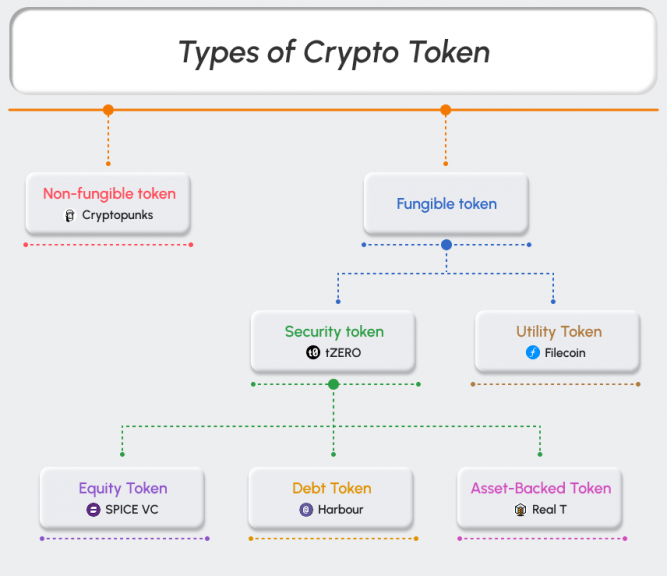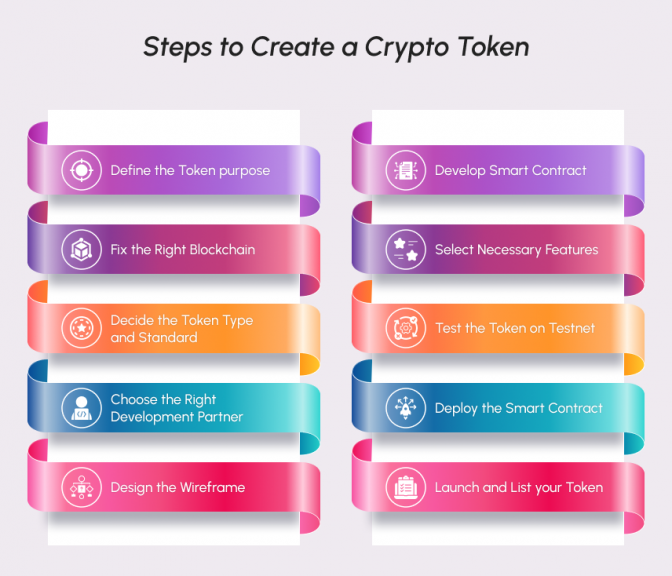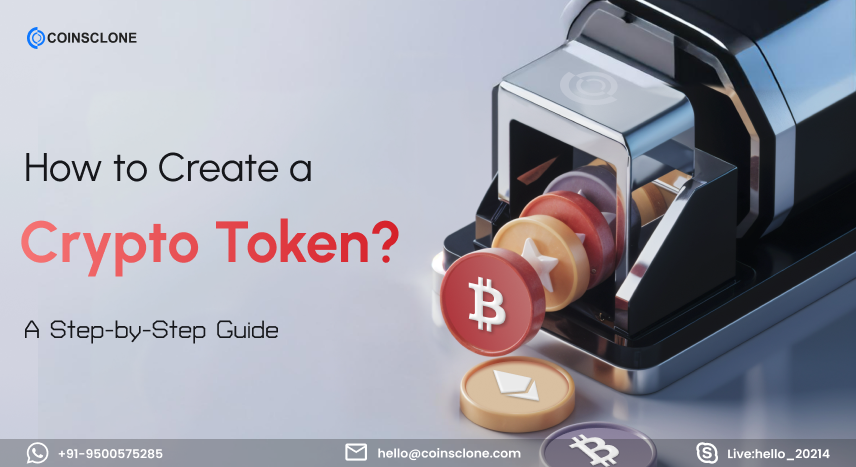As of 2025, the growth of crypto has reached new heights, changing the way we make transactions. Because of this growing interest, many startups want to create a crypto token, which has become the best option for entering the crypto space.
Creating a crypto token will help individuals raise funds for their new projects. Moreover, crypto tokens are the major resource to grab innovations both in blockchain and business. Also, by developing a crypto token, one can use it for services, giving access and gaining a high return on investment. Overall, token creation can benefit those looking to raise funds for new projects, enter the crypto space, or represent real-world assets on the blockchain. If you are one of the mentioned, then this blog covers everything.
In this article, let us have an overview of a crypto token and we’ll explore how to create a crypto token in 10 simple steps. Now we shall start with…
What is a Crypto token and How Does it Work?
A crypto token is referred to as a digital asset that represents a specific value within the blockchain ecosystem. It is often used to raise funds for new projects on crowdfunding platforms. It is also used as an investment, to store value, or to make purchases.
Unlike a crypto coin, which is native to their blockchain, tokens can be created on any existing blockchain using smart contracts. But tokens leverage the security infrastructure of a parent blockchain.
Crypto tokens use blockchain technology to track who owns them and to help with transactions. When a token is created, a smart contract defines its rules and functions. These rules explain how the token can be sent, used, or exchanged. Also, the transactions are recorded on the blockchain, which provides transparency and security.
People can use tokens for different purposes, such as accessing decentralized applications (dApps), participating in governance, or showing ownership of digital or physical assets. The use cases of a particular token depend on its type. In the next section, we explore the…
Types of Crypto token and its purpose
Crypto tokens have become an integral part of the blockchain ecosystem. Also, they represent different forms of digital assets. These tokens are broadly classified into Non-Fungible Tokens(NFTs) and Fungible Tokens. Each has its purpose on the blockchain. Further classifications are…

These various types of tokens show how versatile and innovative Blockchain is. Crypto tokens are changing many fields by creating new ways for people to own, invest, and engage. Once you decided the type of token that aligns with your project goals, you can reach new heights in your crypto business. So, now let us dig deeper into the…
10-Step Process to Create a Crypto Token
The Development steps to create a crypto token offers businesses and individuals a new way to raise funds, incentivize users, or even build decentralized applications. Also, understanding the process of crypto token creation is crucial for ensuring a smooth and successful launch.

Now, let us have a detailed step-by-step process to help you navigate through this complex journey.
Defining the Token Purpose
Clearly defining the goal of a crypto token is the first stage in its creation. A clear goal guarantees that the token’s features complement your target market and company objectives. A token, that is for Initial Coin Offerings (ICOs) or Initial DEX Offerings (IDOs). For example, ought to be created with investor incentives and ease of distribution in mind. On the other hand, governance tokens ought to include decision-making processes for community involvement, whilst utility tokens ought to emphasize compatibility and usability.
Creating a crypto token thorough tokenomics model is also essential. This entails choosing the distribution plan, token quantity, and holder incentives. Also, the potential and usefulness of the token may be clearly understood by stakeholders by creating a thorough whitepaper that details these features.
Choosing the Right Blockchain
Choosing the right blockchain is essential because it has a direct impact on the token’s functioning, transaction speed, scalability, and security. Despite its high transaction costs, Ethereum is a well-liked option because of its strong ecosystem and smart contract features.
As an alternative, Binance Smart Chain (BSC) is perfect for DeFi projects since it provides quicker and more affordable transactions. Other noteworthy choices are Cardano for its safe architecture, Polygon for lower transaction costs, and Solana for scalability.
Transaction speed, security features, developer community, and future scalability are all important considerations while making this choice. You can choose the blockchain that best suits your technological needs and user requirements by carrying out a full comparison investigation.
Also Read: Top Blockchain Platforms to Create and Launch Your Token
Deciding the Token Type and Standard
To specify its functions and compatibility, the right token type and standard must be chosen. ERC-20 is a widely accepted standard for fungible tokens used in DeFi and utility applications on Ethereum. Usually, NFTs use the ERC-721 standard to represent unique digital assets. ERC-1155 supports both fungible and non-fungible tokens, making it perfect for gaming and multi-asset applications, whereas BEP-20 is the Binance Smart Chain equivalent, providing quick and affordable transactions.
Selecting the appropriate standard will be aided by examining the token’s intended use. Making the ideal choice can be further ensured by speaking with blockchain specialists.
Selecting a Development Partner
The success and durability of your token depend on how you create it. You can choose to work with a crypto token development company, hire a developer on your own, or create the token yourself if you have technical know-how.
Partnering with a development company is the best long-term option, even while hiring a developer or making the token yourself could work for tiny projects. The crypto token development company offers complete solutions that cover design, development, testing, and deployment. To guarantee a safe and seamless token launch, they also provide thorough security checks and quicker development schedules.
It is crucial to assess the experience and portfolio of possible development partners. Selecting a development partner with a track record of successful token development can greatly boost the outcome.
Designing the Wireframe
A wireframe provides a graphic representation of your platform UI and token ecosystem. It assists in outlining the smart contract features, wallet and exchange integration points, and user interface flow.
This procedure can be streamlined by using wireframing software such as Adobe XD or Figma. Working closely with designers and developers guarantees that the wireframe offers a smooth user experience and accurately reflects the project’s needs.
Developing the Smart Contract
Smart contracts are the backbone of any crypto token, defining its rules, conditions, and functionalities. The generation and distribution of tokens, transfer methods, features for minting and burning, and, if appropriate, governance functions are all crucial.
Writing secure and clean code is essential to preventing vulnerabilities. The dependability of the contract can be further increased by adhering to industry best practices and carrying out frequent code reviews. Hiring seasoned blockchain engineers and utilizing frameworks like Hardhat and Truffle, improves effective development.
Incorporating Necessary Features
Adding necessary features improvises the functionalities and user experience of the token. Easy access for users is ensured by wallet compatibility with well-known choices like MetaMask and Trust Wallet. Strong security procedures guard against vulnerabilities and hacks. While governance elements let token holders take part in decision-making, staking and incentive systems promote user involvement and token holding.
It is crucial to prioritize features according to project objectives and user needs. Organizing user feedback sessions can guarantee a user-centric approach and assist in identifying extra requirements.
Testing the Token on Testnet
To make sure the token functions effectively and securely, testing is an essential step. While security testing finds and addresses vulnerabilities, functional testing confirms that all token functionalities operate as anticipated. Performance testing evaluates how well the token manages large transaction volumes.
Comprehensive testing involves deploying the token on a Testnet environment and utilizing testing frameworks such as Ganache and Remix. To guarantee a strong and dependable token, any issues must be documented and fixed.
Deploying the Smart Contract
After successful testing, the smart contract is ready for deployment on the chosen blockchain network. This step involves double-checking contract configurations, executing the deployment using tools like Remix or Truffle, and verifying the contract on the blockchain explorer.
Maintaining a backup of the deployed contract is crucial for future reference. Last but not least, keeping stakeholders informed about the deployment keeps them interested and informed about the project’s development.
Launching and Listing Your Token
Making your token accessible to users is the final step. This involves conducting marketing campaigns to attract users and investors, listing the token on popular cryptocurrency exchanges, and engaging with the community to promote adoption.
Partnering with marketing agencies can ensure effective campaigns while submitting applications to exchanges helps increase the token’s visibility and accessibility. Building a strong community around the token fosters loyalty and long-term engagement.
Overall, the steps to create a crypto token involves a detailed and methodical process. Partnering with a trusted crypto token development company can streamline the process and ensure a successful launch. Coinsclone is a leading development partner known for our expertise and end-to-end token development services.
Why Create a Crypto Token with Coinsclone?
Crypto Token Development with Coinsclone is an efficient way to enter the blockchain space due to our expertise in blockchain development, customizable token features, and secure smart contract deployment. We offer end-to-end services, including token creation on popular blockchains like Ethereum and Binance Smart Chain, regulatory compliance support, marketing, and ongoing technical maintenance. By using our services, you can save time and development costs while ensuring a secure, scalable, and well-supported token launch tailored to your project needs.
Create Your Crypto Token Now!
Cost-effective. Exclusive Features. Asset Building. Higher Profits!
Related Articles to Read:
